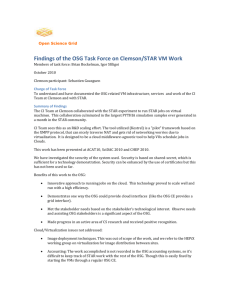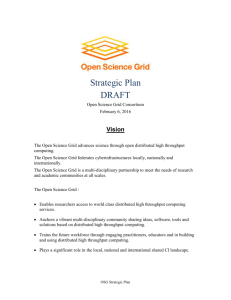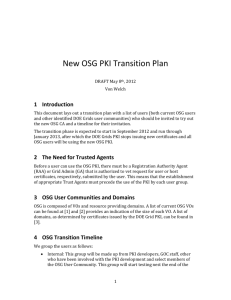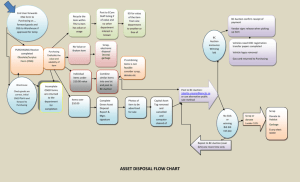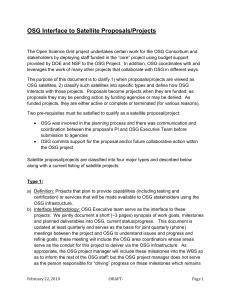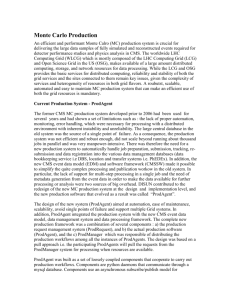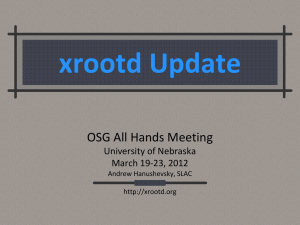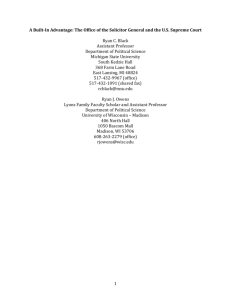OSG Interface to Satellite Projects v4
advertisement
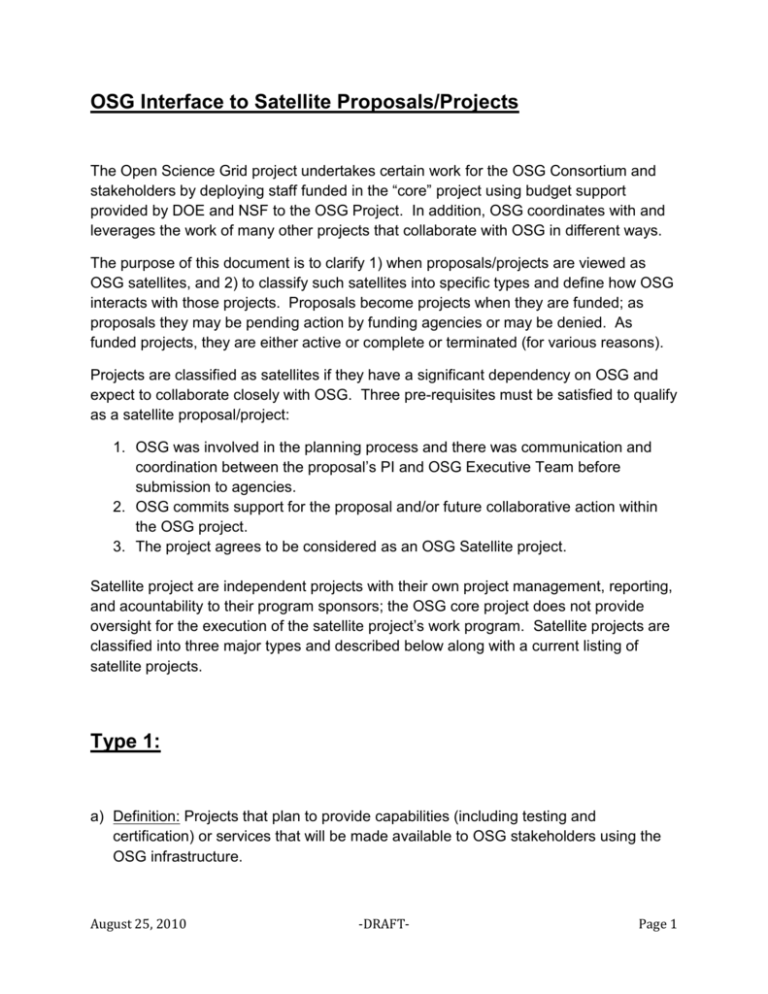
OSG Interface to Satellite Proposals/Projects The Open Science Grid project undertakes certain work for the OSG Consortium and stakeholders by deploying staff funded in the “core” project using budget support provided by DOE and NSF to the OSG Project. In addition, OSG coordinates with and leverages the work of many other projects that collaborate with OSG in different ways. The purpose of this document is to clarify 1) when proposals/projects are viewed as OSG satellites, and 2) to classify such satellites into specific types and define how OSG interacts with those projects. Proposals become projects when they are funded; as proposals they may be pending action by funding agencies or may be denied. As funded projects, they are either active or complete or terminated (for various reasons). Projects are classified as satellites if they have a significant dependency on OSG and expect to collaborate closely with OSG. Three pre-requisites must be satisfied to qualify as a satellite proposal/project: 1. OSG was involved in the planning process and there was communication and coordination between the proposal’s PI and OSG Executive Team before submission to agencies. 2. OSG commits support for the proposal and/or future collaborative action within the OSG project. 3. The project agrees to be considered as an OSG Satellite project. Satellite project are independent projects with their own project management, reporting, and acountability to their program sponsors; the OSG core project does not provide oversight for the execution of the satellite project’s work program. Satellite projects are classified into three major types and described below along with a current listing of satellite projects. Type 1: a) Definition: Projects that plan to provide capabilities (including testing and certification) or services that will be made available to OSG stakeholders using the OSG infrastructure. August 25, 2010 -DRAFT- Page 1 b) Interface Methodology: The OSG Executive team, usually via the OSG project manager, serves as the interface to these projects. We jointly document a short synopsis of work goals, milestones and planned deliverables into OSG, expectations from OSG, and current status/progress. This document is updated quarterly and serves as the basis for joint quarterly (phone) meetings between the project and OSG to understand issues and progress and refine goals; these meeting may include the OSG area coordinators whose areas serve as the conduit for this project to deliver via the OSG infrastructure. As appropriate, the OSG project manager will include these milestones into the WBS so as to inform the rest of the OSG staff. These projects are asked to contribute to the OSG annual report. c) Current Enumeration: 1) Student Funding for ISSGC ’09, (Jha - complete) 2) CI Team (McGee - active) 3) ExTENCI (Avery – active) 4) TG/OSG 2010 Student Workshops (Richard Moore – active) Type 2: a) Definition: Projects that work to directly meet the needs of OSG stakeholders. And the resulting work is expected to be “included” in the OSG at some future time; examples include software that becomes part of the VDT or testing and characterization of grid capabilities that contribute to advancing the OSG infrastructure and principles. b) Interface Methodology: The OSG Executive team, usually via the OSG project manager, serves as the interface to each of these projects. We jointly document a short synopsis of goals, planned deliverables, expectations from OSG, and current status/progress; the intent is to only cover the “touchpoints” between the satellite project and the core OSG project. This document is updated quarterly and serves as the basis of joint quarterly (phone) meetings between the satellite project and the OSG to understand issues and progress. These projects are asked to contribute to the OSG annual report. August 25, 2010 -DRAFT- Page 2 c) Current Enumeration: 1) Adopt-a-Cluster (Livny - active) 2) 100 Gigabit Testing (Livny - active) 3) CorralWMS (Deelman – active) Type 3: a) Definition: Projects that use OSG outputs for further research; they may provide intellectual feedback to OSG but do not substantially change the OSG infrastructure or directly impact the OSG stakeholders. These projects are generally expected to produce outputs for the funding agencies and other collaborations that have the potential for positive impact on OSG. b) Interface Methodology: The OSG Council provides the mechanism for these projects to keep the OSG community informed of their work; a quarterly or semi-annual update is encouraged. c) Current Enumeration: 1) VOSS (Herbsleb - active) 2) VOSS (Ribes – active) August 25, 2010 -DRAFT- Page 3
